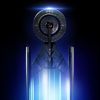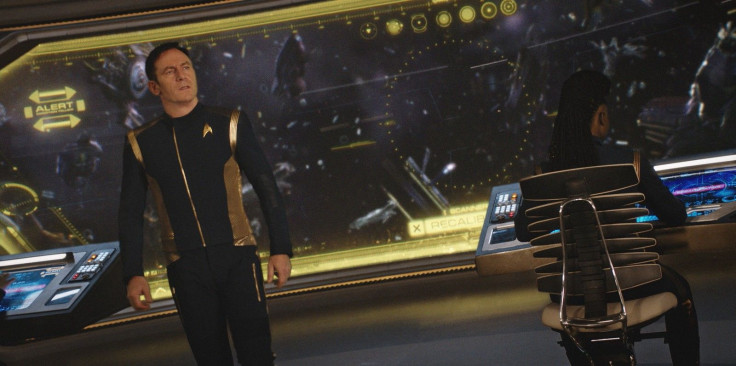While there were hints in the Star Trek: Discovery mid-season finale, “Into the Forest I Go,” pointing to a Mirror Universe visit, a new clip from this Sunday’s episode adds a surprising wrinkle: war with the Vulcans.
The first promo for the upcoming episode “Despite Yourself” depicts a lot of chaos, but leaves the source of it all shrouded in mystery. Overwhelmed by too many jumps with the spore drive, Lieutenant Stamets (Anthony Rapp) appears both debilitated and empowered by the infinite mycelial network his mind/body has traversed. It seems he’ll be unable to use the drive at all for the time being, but even more dangerous could be the new power he’s developing, which looks roughly analogous to the godlike powers developed by Original Series character Gary Mitchell at the edge of the galaxy.
But that’s an internal problem. What about Captain Lorca raising shields? Who’s attacking them?
Now we have an answer, thanks to a short clip appended to the end of a long video of time-lapse set construction. For now, it defies embedding, but there’s really only one takeaway: a Vulcan cruiser attacks the U.S.S. Discovery shortly after Lorca bops them across the dimensional threshold.
When the Vulcans raise their shields and ready their weapons, the Discovery crew assumes a Klingon vessel approaches — time for a team-up! But then the Vulcans fire on them; they’ve entered a different war, the terms of which they don’t understand.
But we do.
Thanks to periodic stopovers in the Mirror Universe, spread over three different Star Trek series, we have a surprisingly broad survey of the alternate dimension’s history. When we’re first introduced to the evil Mirror Universe, in Star Trek: The Original Series episode “Mirror, Mirror,” it looks a whole hell of a lot like the United Federation of Planets we know, just with more murder. Spock still serves with Kirk, their relationship more backstabbing but still fitting to the same basic parameters. But in “Mirror, Mirror,” Spock surrounds himself with other Vulcans, indicating divides of power and prejudice between the species. Everything isn’t quite so equal between the Vulcans and the Terrans of Earth.
Star Trek: Enterprise episodes set in the Mirror Universe offer a revised version of history. In both the Mirror Universe and the Star Trek prime universe, Zefram Cochrane invented a warp drive and attracted Vulcan first contact to Earth in 2063. But rather than an almost post-apocalyptic and wartorn planet, the Vulcans of the Mirror Universe landed, got shot and had all their stuff stolen. The Terran Empire reverse-engineered Vulcan technology and swept through the galaxy. By the time Star Trek: Discovery takes place, Vulcans are a well-integrated client state of the Empire, with individual Vulcans like Spock rising through the ranks by carefully maintaining a base of Vulcan support while remaining meticulously loyal to the Terrans.
This leaves a few possibilities open for the state of galactic relations in “Despite Yourself.” It seems strange that a Vulcan ship would open fire on a ship of obvious Terran design (even a weird one like the NCC-1031), so it may be the Discovery happens upon some sort of Vulcan rebellion.
There’s another alternative: has Star Trek: Discovery gone full-blown Rick and Morty? Alternate dimensions has been a part of Star Trek since the beginning, though it didn’t much resemble the current pop-culture perception of the multiverse until Star Trek: The Next Generation episode “Parallels,” in which Worf bounces through a quantum fissure and experiences a cascade of mildly variant, overlapping universes. Since then, the Mirror Universe has popped up again and again more for tradition’s sake than anything. Discovery might not be in the Mirror Universe, but any of universe of infinite possible designs. But probably not, many of the hints point to the Mirror Universe as we understand it in the original “Mirror, Mirror” (including in the fifth episode, “Choose Your Pain, which ends with a creepy Stamets lingering in a, wait for it… mirror).
And what Star Trek series writer worth his or her combadge could resist adding another page to the Mirror Universe’s tumultuous history?
At the end of “Mirror, Mirror,” having witnessed the less violent Federation universe, Spock pledges to reform the Mirror Universe, step-by-step, taking power in order to change the moral arc of his galaxy. It’s a daunting task, but the episode leaves reason for hope, this is Goatee Spock we’re talking about, after all. The next time we visit the Mirror Universe, in Deep Space Nine, those hopes are dashed to pieces. Spock did indeed take power and enact reforms, but his revolution made the Terran Empire vulnerable to a surging Klingon-Cardassian Alliance. The galaxy turned out even worse than it would have. Which is maybe the saddest and most interesting quality of the Mirror Universe: more than a place where people are mean, it’s a place where all of the Federation’s noblest qualities lead to ruin. Lorca should fit right in.
“Despite Yourself” will be available to stream on CBS All Access Sunday, Jan. 7 at 8:30 p.m.
- Richly redesigned Klingons
- Complex and explicable motives
- Great new Starfleet characters
- Incredible production design
- Generic space combat and action
- Too many flashbacks
- Eschews subtext, doesn't put enough faith in the audience





![Best Gaming Mouse For Gamers With Smaller Hands [2025]](https://d.player.one/en/full/227430/best-gaming-mouse-gamers-smaller-hands-2025.png?w=380&h=275&f=fdcf47c1c5fc58d1e41d3be505c12568)













